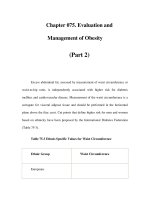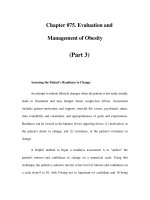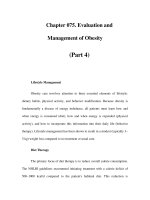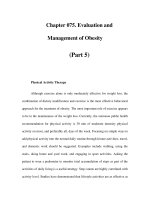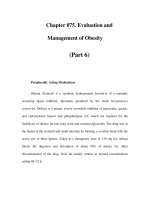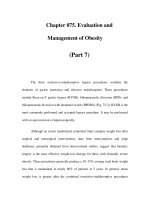Chapter 104. Acute and Chronic Myeloid Leukemia (Part 14) pot
Bạn đang xem bản rút gọn của tài liệu. Xem và tải ngay bản đầy đủ của tài liệu tại đây (11.89 KB, 5 trang )
Chapter 104. Acute and Chronic
Myeloid Leukemia
(Part 14)
The Patient
Patients should have acceptable end-organ function, be <70 years, and have
a healthy, histocompatible donor. Furthermore, survival after SCT in the
accelerated and blastic phases of the disease is significantly diminished and is
associated with high rates of relapse. Bone marrow transplantation (BMT) early in
the chronic phase (1–2 years from diagnosis) is superior to later BMT. In the
imatinib era, allogeneic transplantation should be used when possible for patients
with accelerated/blastic phases of the disease or those whose disease fails to
respond or progresses on imatinib.
The Donor
Transplantation from a family donor, who is either fully matched or
mismatched at only one HLA locus, should be considered for any patient with
CML who is a candidate for an HLA-related sibling transplant. Syngeneic BMT in
patients with chronic-phase CML results in 7-year disease-free survival in 55% of
patients, with a 30% relapse rate.
BMT with an HLA-identical sibling in the chronic phase achieves 5-year
disease-free survival in 40–70% of patients, with a 25% relapse rate. BMT from
an HLA-matched unrelated donor in chronic phase <1 year from diagnosis and
<30 years of age results in 5-year disease-free survival similar to matched-sibling
donor transplantation.
For all other groups, patients receiving BMT from unrelated donors have
higher rates of graft failure and acute and chronic GVHD and prolonged
convalescence after treatment, compared to those who receive allogeneic
transplants from related donors.
Sex mismatch has an adverse effect on transplantation, with worse outcome
associated with a female donor and male recipient. This has been attributed to
GVHD against the male histocompatibility Y antigen.
Peripheral blood is now being studied as a source of hematopoietic
progenitor cells; it may offer rapid engraftment and less risk for the donor. With
unrelated donors, some studies demonstrated no difference in GVHD and
improved disease-free survival when comparing peripheral blood to bone marrow
stem cells.
Using matched sibling donors in chronic-phase CML, marrow stem cells
led to a higher cumulative incidence of relapse at 3 years, while peripheral blood
stem cell recipients had a higher cumulative incidence of chronic GVHD. At the
current time, some centers collect bone marrow and some peripheral blood from
sibling donors for newly diagnosed chronic-phase CML patients.
Patients with more advanced stages are offered peripheral blood SCT.
Umbilical-cord blood may permit mismatched SCT with notably less GVHD;
GVL effects do not appear to be impaired. A problem with cord blood is obtaining
a sufficient number of progenitor cells to reconstitute hematopoiesis in an adult.
Preparative Regimens
Myeloablative regimens have been studied by several groups.
Cyclophosphamide plus total-body irradiation is comparable to busulphan plus
cyclophosphamide in the 3-year probabilities of survival, relapse, event-free
survival, speed of engraftment, and incidence of venoocclusive disease of the
liver. Significantly more patients in the total-body irradiation arm experienced
major elevations of creatinine, acute GVHD, longer periods of fever, positive
blood cultures, hospital admissions, and longer inpatient hospital stays. However,
increased chronic GVHD, obstructive bronchiolitis, and alopecia were noted with
busulphan. Measurement of busulphan levels revealed no significant association
between busulphan levels and regimen-related toxicity, but low levels were
associated with an increased risk of relapse. Intravenous busulphan allows better
control of serum levels.
Reduced-intensity transplants in which the preparative regimen is aimed at
eliminating host lymphocytes rather than bone marrow have been reported by
numerous groups. No randomized trials comparing the two approaches have been
published. Retrospective comparisons reveal that reduced-intensity conditioning
regimens produce equivalent or acceptable results (in toxicity as well as outcome).
Reduced toxicity with preserved antitumor efficacy is the goal, and therefore
reduced-intensity transplantation is our recommendation.
Development and Type of GVHD
Development of grade I GVHD (Chap. 108) decreases the risk of relapse
compared to no GVHD. An even lower relapse rate was observed in patients with
grade II GVHD but was accompanied by a substantially higher transplant-related
mortality rate. The decreased relapse rate may be caused by a GVL effect.
Depletion of T lymphocytes from donor marrow can prevent GVHD but results in
an increased risk of relapse, which exceeds the relapse rate after syngeneic SCT.
Thus, T lymphocytes from the donor marrow mediate a significant antileukemic or
GVL effect, and even syngeneic marrow may exhibit limited GVL activity in
CML.




